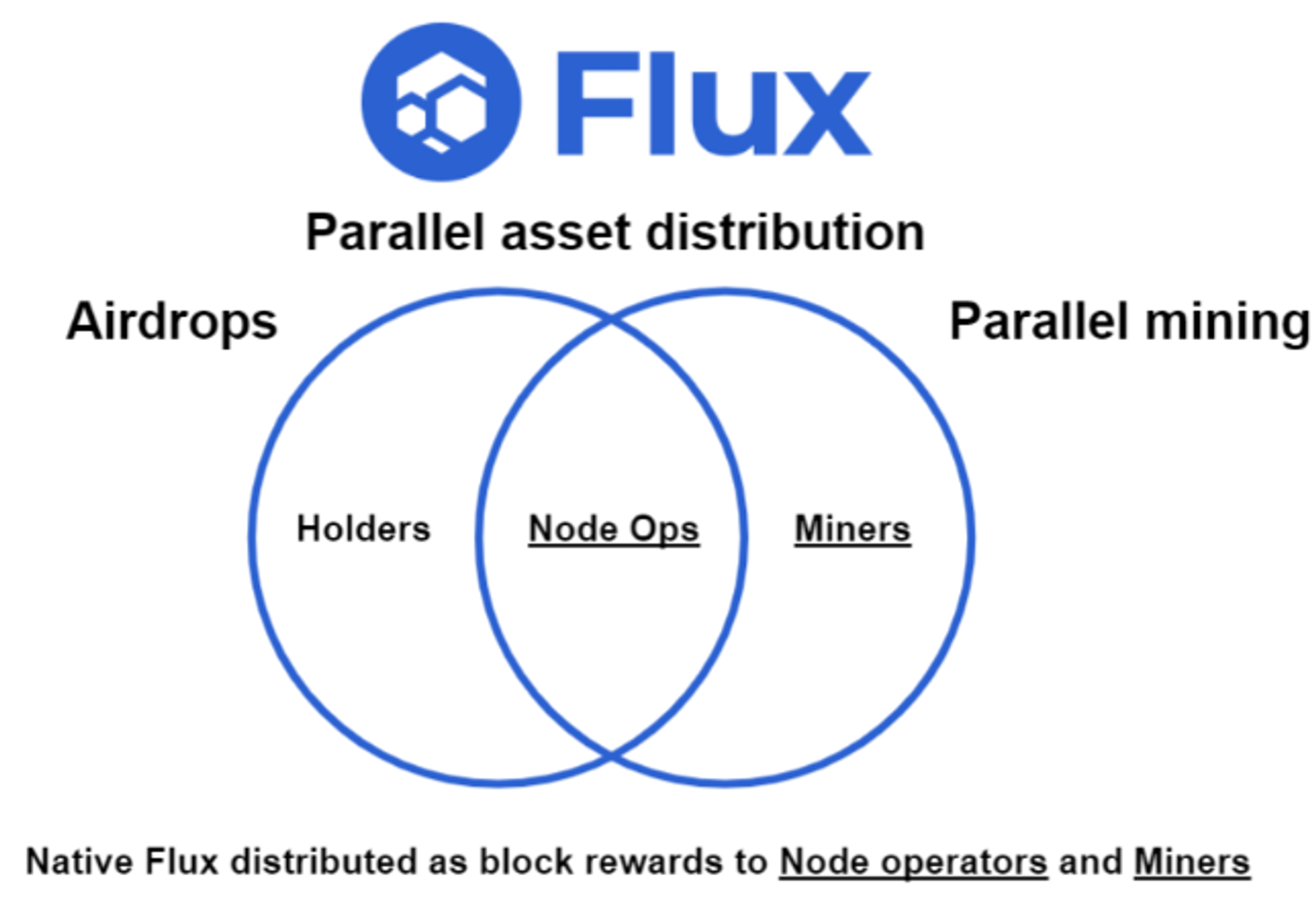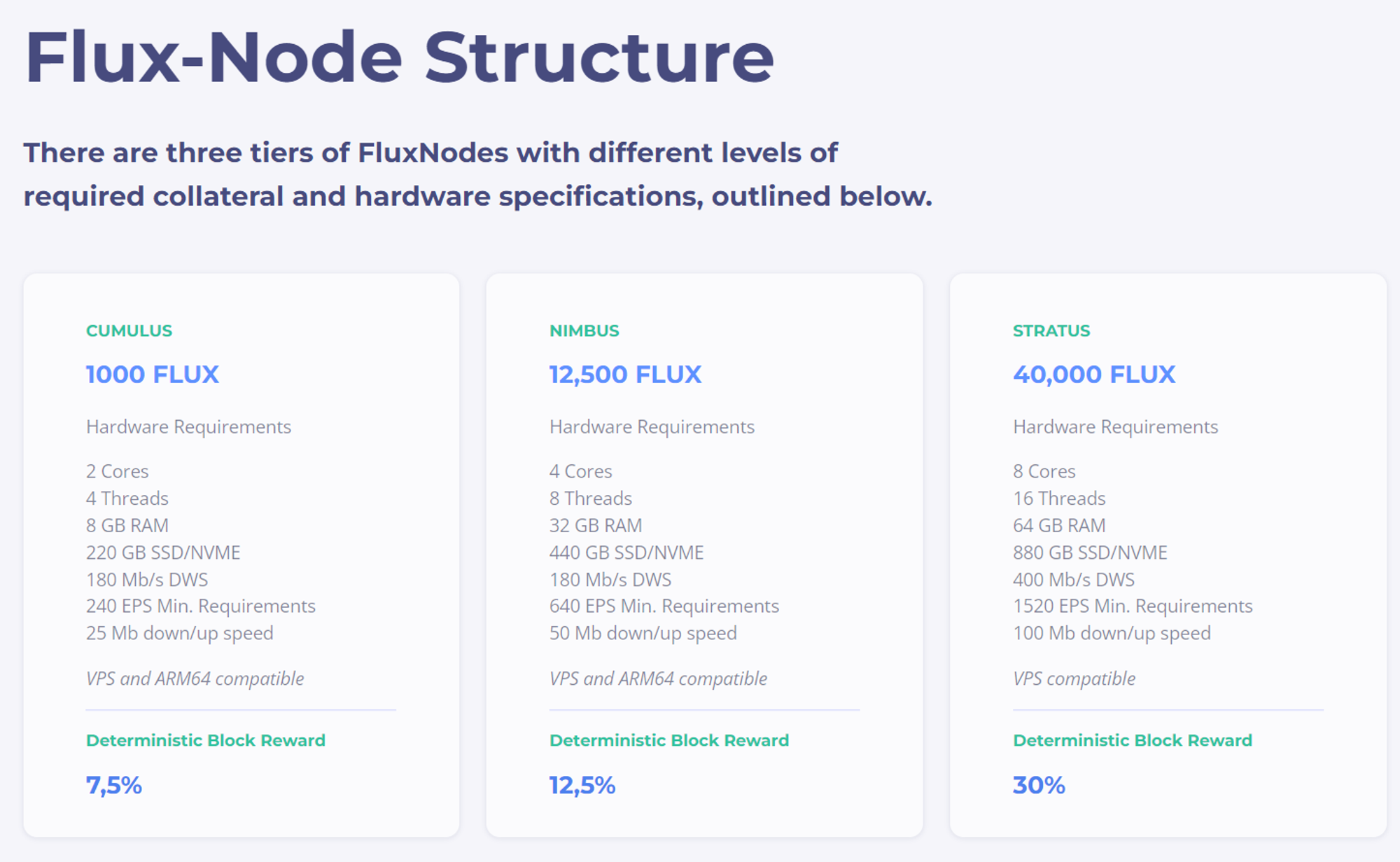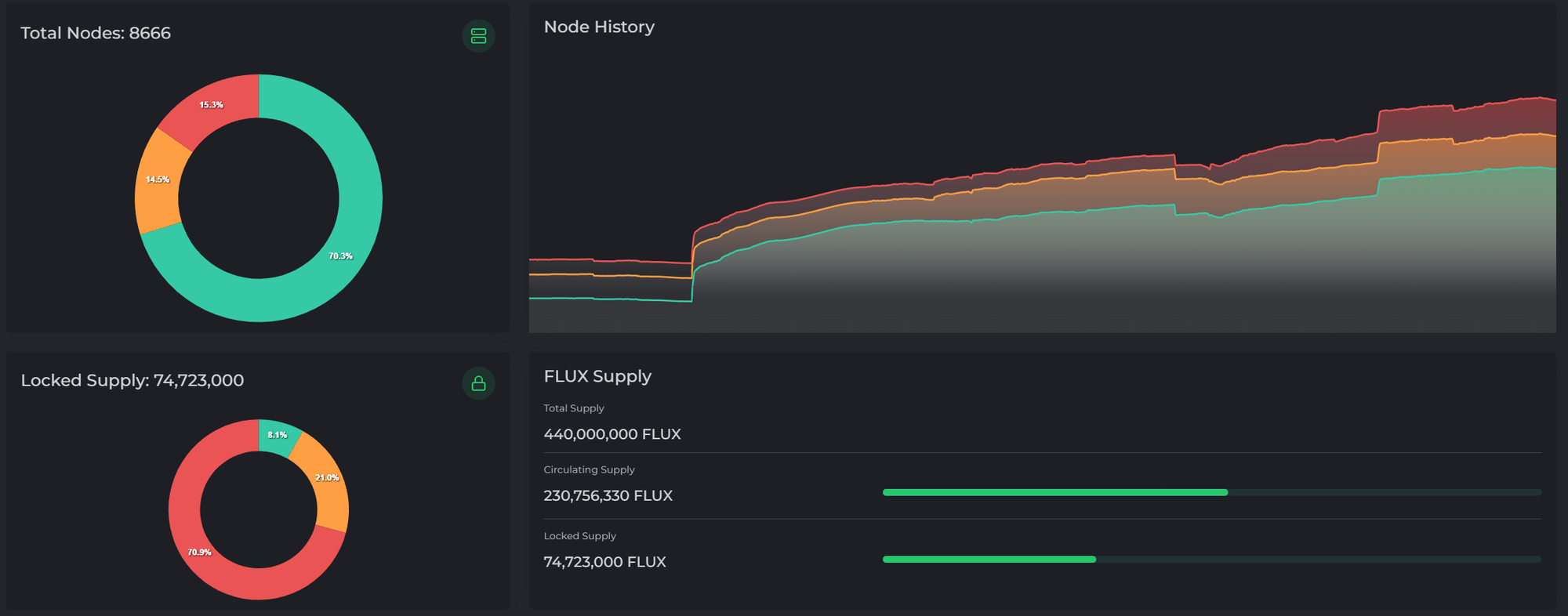ARTICLES
TWITTER THREADS
LINKS
- Website - https://runonflux.io/index.html
- Whitepaper - https://runonflux.io/documents/ZelHash_v1.0.pdf
- Twitter - https://twitter.com/RunOnFlux
- Discord - https://discord.com/invite/PtWVF9phR4
- Roadmap - https://runonflux.io/roadmap.html
- Projects - https://home.runonflux.io/apps/globalapps
WHAT IS IT
Flux is the AWS (amazon web services) of web 3.0 and so much more! The Flux Ecosystem is a suite of decentralized computing services and blockchain-as-a-service solutions. This offers an interoperable, decentralized AWS-like development environment. Flux uses a consensus model called “POW” or “Proof of work” to power its ecosystem. This provides an incentive for hardware hosters, governance on-chain, and bad actor mitigation via staking requirements for running hardware utilizing the $FLUX coin.
“Proof of work and proof of stake are two blockchain consensus models that are used to ensure the validity of transactions in cryptocurrency trading. Proof of work involves solving complex cryptographic mathematical equations using computing power. In contrast, proof of stake miners stake their digital coins for the right to validate new block transactions.”
$Flux coin was fairly distributed without any pre-mined coins or distributions other than holders, miners, and node operators. It is an open-source, community-driven, and independent project without any outside investors.
Flux is a Layer 1 and Layer 2 blockchain, the layer 2 is called → FluxOS. An operating system running on top of Linux to manage the network by verifying and benchmarking compute power, deploying, running, and load balancing decentralized applications, managing XDAO governance, and more.
Flux also has multiple Parallel Chains which provide Interoperability, and mining incentives and makes for an easy bridge from within the Zelcore wallet, so the Flux coin can be used on various other blockchains.
FLUXOS
FluxOS is the essential cloud infrastructure used to power the new decentralized web. Its architecture is a second-layer operating system that allows Web3 applications to run seamlessly on the computational platform. It safely secures users’ data on thousands of nodes worldwide. The nodes are redundant, which means another immediately takes over in the case of the failure of one node.
- Decentralized cloud computing
- Decentralized website hosting
- File storage
- Decentralized nodes for Dapps
App creators, blockchain builders, web designers, and any type of developer can Dockerize their innovations and easily deploy them on reliable, scalable decentralized infrastructure.
There are endless use-cases for the Flux network including:
- Blockchain as a Service – Hosting blockchain nodes and apps.
- DApps – Run decentralized applications.
- Oracles – Run apps to provide decentralized data sets (DibiFetch is achieving this by pulling pricing data for cryptocurrencies from multiple exchanges).
- Price Rate Servers – The ZelCore wallet pulls all pricing data from price rate servers running on FluxOS.
- Game and web servers - Hosting of game and web servers to provide content for end-users.
Once deployed, FluxOS ensures all nodes are running properly and communicating throughout the network and ensures the correct number of instances are running.
Built using Mongo, Express, Vue, and Node (MEVN Stack), FluxOS is a highly-accessible playground for developers that is completely open-source.
PARALLEL ASSETS
Flux parallel assets are Flux tokens on other blockchains. Native Flux can be swapped to and from any of the parallel assets available. No matter what assets are swapped, native Flux and flux parallel asset swaps always happen at a 1:1 ratio. Swapping is done in the official Flux wallet called Zelcore
using the Fusion app.
“You can compare the parallel assets to expatriate citizens. They are native to Flux but are living abroad. They have all the benefits of the foreign ‘country’ they reside in, but can always return home, it’s like they’re holding two passports.”
Example:
A Flux-ETH token lives on the Ethereum blockchain and is no different from any other token on that chain. It can partake in trading on Uniswap, earn fees by being locked in a liquidity pool, and so on, it also abides by all the rules on that blockchain such as the fee structure or any other inherent mechanics. However, unlike other tokens on Ethereum, this one can be swapped back to native Flux at any time using a 1:1 swap ratio.
The cross-chain swaps can only happen because Flux has locked swap supplies on all parallel chains. When swaps are made the assets are locked in the swap supply on one chain and then released on another. The swaps are always 1:1. This allows Flux holders various extra use cases for their coins.
Parallel Mining is the distribution of parallel assets that are being added with new blocks. “every two minutes”. The block reward for every block is 75 Flux, this reward is evenly split 50/50 between GPU miners and Flux node operators. For every Flux block reward, a tenth of that is distributed as parallel assets to miners and node operators.

This highly incentivizes miners and node operators essentially double their block rewards once all ten parallel assets are in play. so 10% x 10 for each parallel asset they have in play. Even though all the parallel assets aren’t all launched, they are still accounted for. Meaning miners and node operators will receive rewards retroactively once launched.
Parallel assets bring with them the following benefits:

INFINITY CONTRACTS 3.0
Infinity Contracts aka applications in flux solve many existing issues of current smart contracts as we know them.
You can write your “infinity contracts” in any language you want: C, C++, #Java, Go, #Javascript, or any other. This itself is huge and simplifies things for #developers as they can just work with the stack they are already familiar with.
No hardware limitations. Your app can use multiple cores and store gigabytes of data.
No fees for running. In “infinity contracts” 3.0, the Flux app users themselves don't pay any gas chain fees for running and using your app.
More powerful! Your app can do just almost anything.
Upgradability: something is missing, or not working? Just perform an update to it.
Scalability: Your #app is getting popular with 100X users? Not an issue. More #fluxnodes are now running your app to satisfy the demand. Explanation credit to “https://twitter.com/Smr91Edgar” Via Twitter: https://twitter.com/cramedgar/status/1433043113036161027
NODES/MINING
Flux incentivizes holders, GPU miners, and node operators through airdrops, mining, and node rewards. To become a FLUX node operator, one must have at least 10k FLUX in order to set it up. So this 10k FLUX now becomes TVL. Flux’s circulating supply comes from the miners. No VCs, NO ICO just mining.
Flux node operators can choose from 3 tiers of hardware requirements to stand up after providing the necessary Flux capital soft-locked in their wallet. This allows almost anyone to be rewarded for providing hardware to the network, from anywhere in the world.
GPU mining = Involves the use of a gaming computer’s graphics processing unit to solve complex math problems to verify electronic transactions on a blockchain.
- Confirm transactions
- Secure the blockchain
- Participate in the fair distribution of new Flux coins
Node Operators = Store spread, and preserve the blockchain data, and thus it can be said that a blockchain exists on nodes.
- Validate transactions
- Keep a historic record of transactions
- Dictate and enforce the rules of the network.
Around every two minutes, a new block is created. The block reward for every block is 75 Flux, this is split 50/50 between Flux GPU miners and Flux node operators, so 37.5 to each. For every native Flux block reward, a tenth of that is distributed as parallel assets to miners and node operators.
The monthly payout at current price levels of flux ($1.63) is as follows:
- Cumulus: $38.56 USD
- Nimbus: $375.91 USD
- Stratus: $858.59 USD

TOKENOMICS
Flux started three years ago as Zelcash, but on March 17th of 2021 as Zelcash was hard forked into Flux. Flux the circulating supply of 123 million was converted 1:1 to Flux and the new maximum circulating supply for Flux was set at 440 million Flux.
Initial distribution will ensure that there are 220 million native Flux and 220 million in parallel assets. A 1:10 ratio between native Flux and each of the ten parallel assets

Currently, on April 7th 2022, Flux has 8644 nodes operating its decentralized network and each node requires you to lock 10,000+ (recently updated to only 1k) Flux resulting in a massive amount of TVL.

